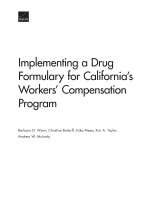| 来源类型 | Research Reports
|
| 规范类型 | 报告
|
| DOI | https://doi.org/10.7249/RR1560
|
| 来源ID | RR-1560-DIR
|
| Implementing a Drug Formulary for California's Workers' Compensation Program |
| Barbara O. Wynn; Christine Buttorff; Erika Meza; Erin Audrey Taylor; Andrew W. Mulcahy
|
| 发表日期 | 2016
|
| 出版者 | RAND Corporation
|
| 出版年 | 2016
|
| 页码 | 143
|
| 语种 | 英语
|
| 结论 |
The Division of Workers' Compensation (DWC) Will Need to Weigh the Benefits of Remaining Consistent with the Current MTUS Structure Against the Ease of Implementing the Formulary- To remain consistent with the MTUS guidelines, DWC will need to either adopt existing the guidelines and formulary (the Work-Loss Data Institute's ODG or The Reed Group's ACOEM) or derive the formulary drug listing from MTUS guidelines.
- The existing sources have advantages and disadvantages. The ODG guidelines are more comprehensive and updated regularly. The formulary drug listing has prospective review (PR) requirements and could be implemented off the shelf. The MTUS guidelines for chronic pain are based on ODG, although most MTUS guidelines are based on ACOEM. The ACOEM guidelines have a more rigorous development process but are less comprehensive. Updates occur every three to five years. The drug recommendations are condition-specific, with no PR requirements. DWC would need to develop a formulary drug listing and PR requirements.
- The MTUS guidelines are outdated. An MTUS formulary would require updating the guidelines; developing a formulary drug list and PR requirements; and, if the current multisource structure is retained, integrating guidelines from different sources into a single formulary.
- The Labor Code's different administrative processes for updating the treatment guidelines and the formulary pose challenges for maintaining currency and consistency between the guidelines and formulary recommendations.
|
| 摘要 |
- The MTUS guidelines should drive decisions on the formulary structure so that both treatment guidelines and the formulary incorporate the evidence-based standards of care that best meet the needs of California's injured workers. Priority should be given to updating the MTUS guidelines. In doing so, the advantages and disadvantages of retaining the current multisource guideline structure should be weighed.
- The formulary drug listing and prospective review (PR) requirements should be derived from the MTUS guidelines in effect as of the implementation date. Generally, PR should be waived for recommended drugs that are first-line therapies or that are otherwise low-cost, low-risk drugs that are prescribed consistent with the MTUS guidelines. Condition-specific PR requirements should be imposed sparingly when there are significant differences in the drug recommendation.
- DWC should also consider the following: a first-fill policy that waives PR for drugs prescribed immediately following injury, including a short-course of opioid therapy for severe pain; requiring PR if a brand name drug is prescribed when a generic equivalent is available at lower cost.
- The formulary should incorporate cost considerations over time through the Pharmacy and Therapeutic Committee's review activities.
- Consideration should be given to revising the Labor Code to provide DWC with authority to post changes in the MTUS treatment guidelines for drug therapies simultaneously with changes in the formulary without rulemaking.
|
| 主题 | California
; Health Insurance Benefit Design
; Insurance Claims
; Prescription Drug Benefits
; Workers' Compensation
|
| URL | https://www.rand.org/pubs/research_reports/RR1560.html
|
| 来源智库 | RAND Corporation (United States)
|
| 引用统计 |
|
| 资源类型 | 智库出版物
|
| 条目标识符 | http://119.78.100.153/handle/2XGU8XDN/108378
|
推荐引用方式
GB/T 7714 |
Barbara O. Wynn,Christine Buttorff,Erika Meza,et al. Implementing a Drug Formulary for California's Workers' Compensation Program. 2016.
|
|
文件名:
|
x1500294922722.jpg
|
|
格式:
|
JPEG
|

|
文件名:
|
RAND_RR1560.pdf
|
|
格式:
|
Adobe PDF
|
除非特别说明,本系统中所有内容都受版权保护,并保留所有权利。